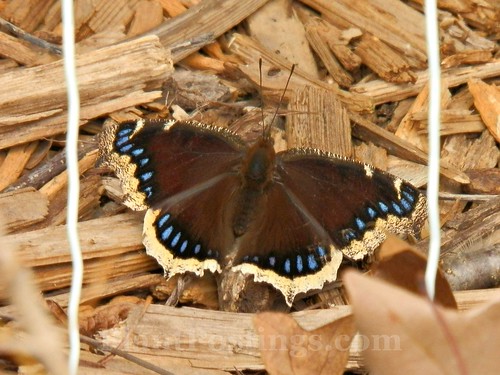
Can you imagine a garden without butterflies? Or a neighborhood, or a world without butterflies? Lately, I've been thinking how sad it would be if my grandchildren (or great-nieces or great-nephews or later generations) couldn't experience the beauty of a simple butterfly.
(Don't worry, this post won't be overly melancholic. There is reason to worry about butterflies' survival in our world, but I'll save that for another post.)
It's not difficult, currently, for me to imagine that kind of world because my garden has gone to sleep for the winter. I won't see butterflies for a few months now. Then again, I have the hope that I'll see many again when the weather warms.
Today, I'm simply thankful for what I've experienced. And hopeful that future generations will be able to experience these graceful insects, too.
In this part of the world, the past growing season has blessed us with plentiful butterflies of many species. For me, it started in early April, with the first one being a Mourning Cloak (Nymphalis antiopa), shown in the first photo of this post. It gracefully floated by my window on a warm breeze and landed in a sunny spot to bask. Mourning Cloaks are often the first and last butterflies we see here each season.

Next came the plentiful American Coppers (Lycaena phlaeas)--too numerous to count--up at our cottage in Marquette County. An open field there is thick with Sheep's Sorrel (Rumex acetosella), which likely explains their abundance as it's a larval host plant for the species.
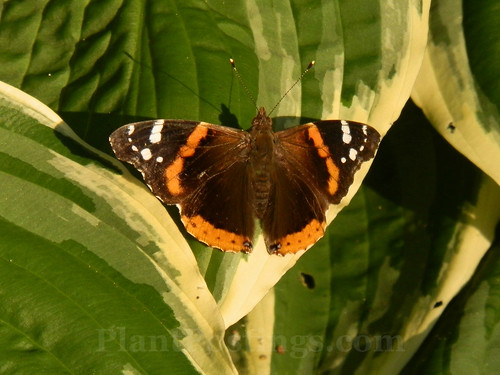
Then, one late afternoon in early summer, as I was gazing outside, I noticed several bright, orange-red butterflies darting and swooping and then returning to the same spot. When I went outside to investigate, I discovered they were Red Admirals (Vanessa atalanta). Apparently, this flight pattern is common for this species.
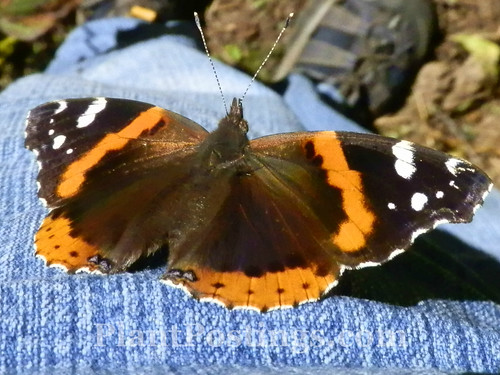
It seemed to be a good year for Red Admirals. I saw them in numerous spots throughout the state and throughout the season. This one even landed on my pant leg as I was photographing plants.
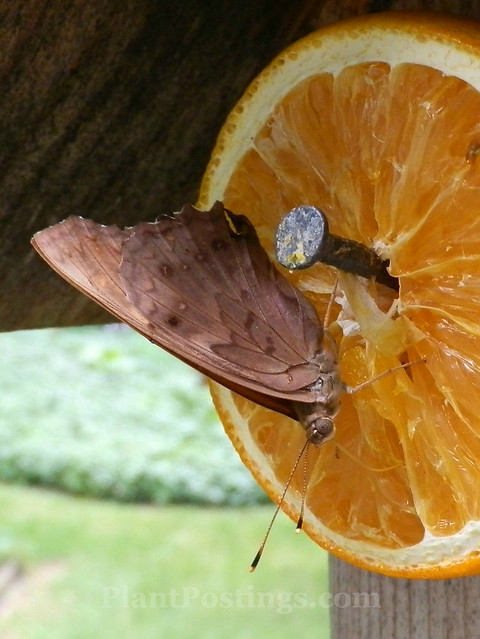
Just as I was about to stop posting oranges for the Orioles, this little fellow showed up. I learned it was a Tawny Emperor (Asterocampa clyton), which often feeds on rotting fruit.

This Tawny Emperor (or a friend) made repeated visits, and for a few days in a row it rested on and consumed the oranges for several hours straight.
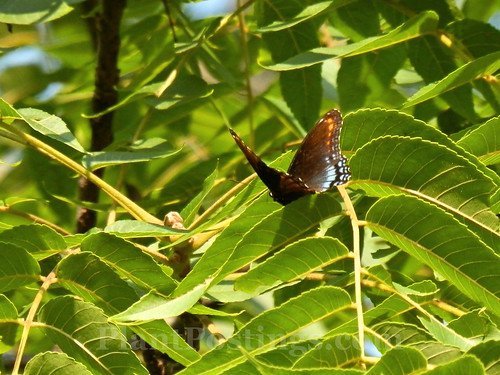
Near the same spot at our cottage where I saw the American Coppers and the Red Admirals, this Red-Spotted Purple (Limenitis arthemis astyanax) paid a visit. At one point, it landed on the fishman's hand, and then basked in the sun in the upper branches of this Ash tree.

On various hikes throughout the summer, we saw Viceroys (Limenitis archippus), which mimic Monarchs; and

Pearl Crescents (Phyciodes tharos), a very common butterfly in the Eastern U.S.
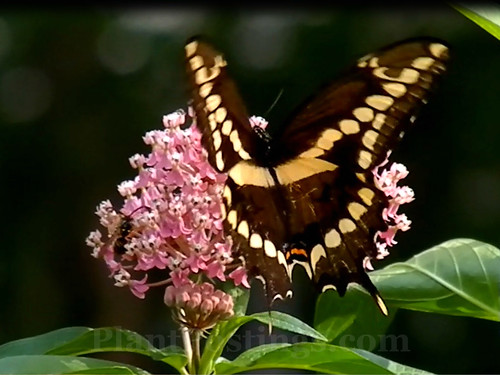
And then there were the surprises, like this Giant Swallowtail (Papilio cresphontes), which is less common in my state. I don't ever recall seeing one before. It was huge--I'd estimate a wingspan of five to six inches! It was difficult to photograph, because its wings flapped so fast. (The above photo is a stop-action clip from a video.)

In this photo, you can see the beautiful, bright underside of its wings. I learned that, along with Monarchs, the Giant Swallowtail is attracted to Swamp Milkweed (Asclepias incarnata), and that its larval host plants include members of the Citrus family.
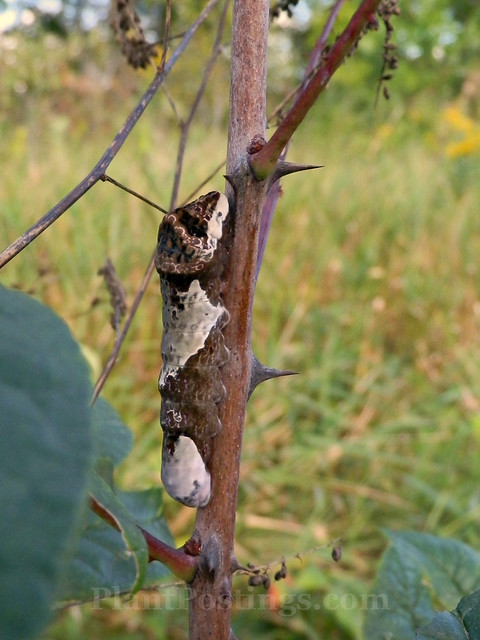
Another host plant is Prickly Ash (Zanthoxylum americanum), which is more common in my northern locale than Citrus. I nearly missed this Giant Swallowtail (and its friend below) when I walked by it during a hike one day. It's hard to believe a squishy caterpillar can survive those sharp thorns, but I guess it knows what it's doing.
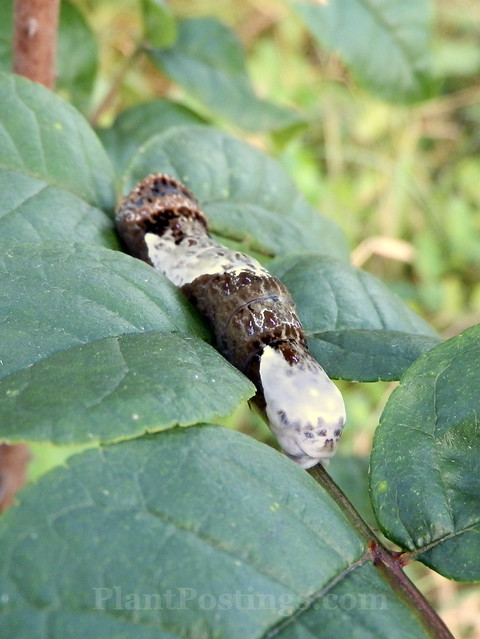
Its camouflage makes it look like bird droppings. Fascinating.
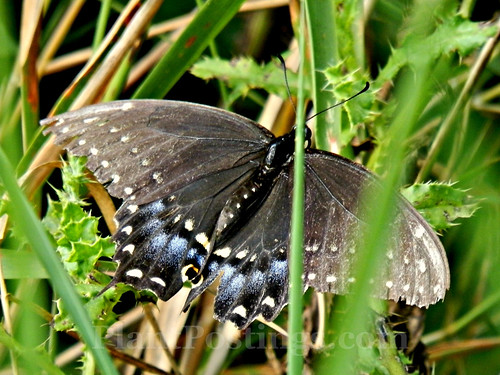
I also had the pleasure of seeing many Black Swallowtails (Papilio polyxenes) and Eastern Tiger Swallowtails (Papilio glaucus). (I didn't get any decent photos of the latter this year and I didn't want to cheat by using an old photo from last year. Tiger Swallowtails didn't seem quite as numerous this year as last--at least not in my garden and surroundings.)
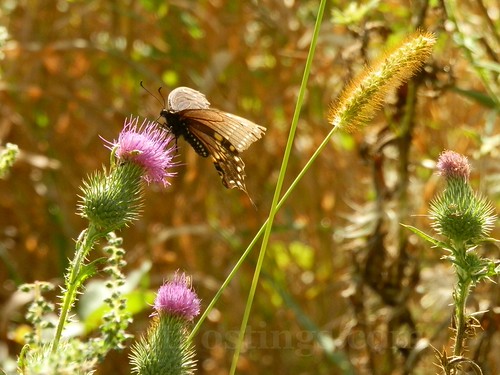
There was something mystical about this scene. This battered butterfly was somewhat difficult to identify and was probably at the end of its life. But it had just enough markings on its wings and body to identify it as another Black Swallowtail.

Believe it or not, the most plentiful butterfly in my garden this year was the Monarch (Danaus plexippus). By now, I suppose, just about everyone is aware that their numbers (at least the migrating Monarchs in the central and Eastern U.S.) were at a record low in North America in 2013.
But starting in mid-June this year, their numbers began exploding in this part of the state. And once the Swamp Milkweed began to bloom in my garden, I saw at least one (and sometimes many more) each day. I felt truly blessed.
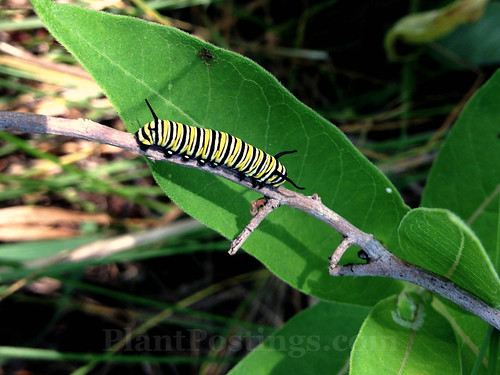
During a trip to the cottage, I found this Monarch caterpillar. The property is thick with Milkweed plants of various species. I believe this is Common Milkweed (Asclepias syriaca). Later in the summer, when I transplanted some A. syriaca to my home garden, I found a tiny instar cat, which I supplied with fresh Milkweed in a very sheltered area of the garden. I didn't bring it inside to raise it (which I regret), but it was a very healthy fifth instar before it crawled away to form a chrysalis.
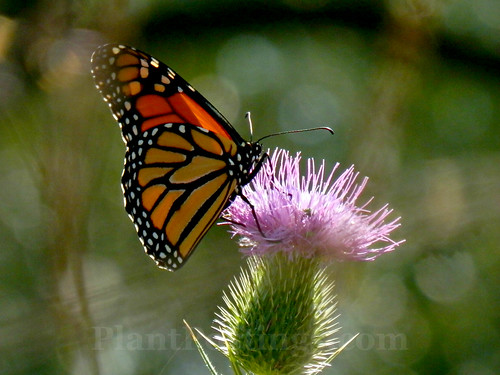
We also saw many Monarchs during our hikes, like this healthy one enjoying nectar from a Thistle.
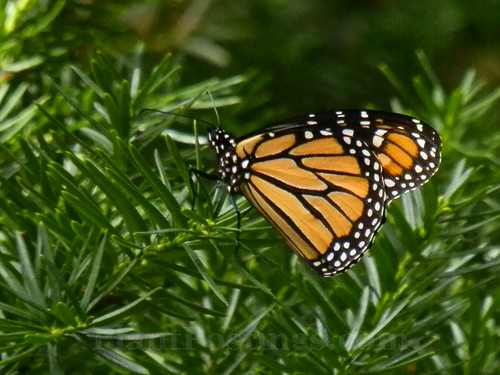
I never did find the chrysalis from that Monarch cat in my garden, but about 10-12 days later, two fresh and healthy, nearly perfect Monarchs were mating and then resting on the Yew shrubs. One seemed to linger a bit before it floated away on a breeze. Silly me for thinking it was the one I'd fed and nurtured.
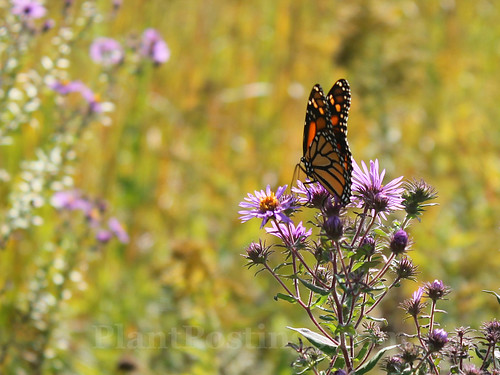
There were still many more Monarchs to see--nearly every time I hiked.

One autumn day at the cottage, we saw numerous Monarchs migrating gracefully along the lakeshore, resting briefly on leaves and on flowering plants in the bright sunlight.
I thought, perhaps, those would be among the last Monarchs I would see. But they kept coming.
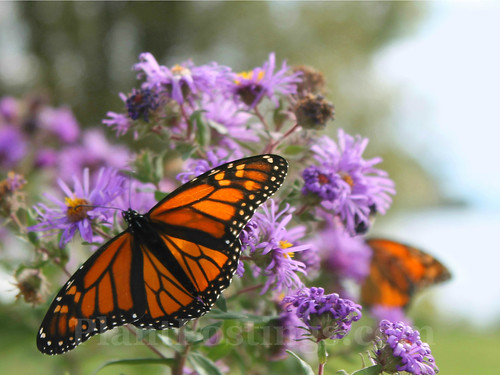
The last butterflies I saw this season were these Monarchs and their 10 or so friends. We'd already had a light frost, and I didn't expect to see anymore. But a fortuitous trip to the northeast corner of Lake Mendota to photograph fall foliage revealed this gift. It was an unexpected moment of grace.
I thought it would be fun to try out Google's Auto Awesome feature with some of my butterfly photos and videos. All you have to do is create a folder in Google Photos and add your photos and videos. The Google people automatically add music and transitions, and then notify you when your Auto Awesome video is ready. I should have labeled the photos so perhaps they would have added text, too. But as simple as it is, the resulting video is light and rather hopeful. I like the way it ends with the fifth instar Monarch caterpillar.
What a beautiful world it is when the butterflies (and caterpillars) are with us!
Thanks to wisconsinbutterflies.org and Butterflies and Moths of North America, for help identifying these and other species of butterflies.
(I'm taking a short break. My next planned post will be at the end of the month for the "Garden Lessons Learned" meme. To all those who celebrate Thanksgiving, I do hope you'll have a safe, healthy, and happy holiday. And thanks, to everyone who reads this, for your friendship!)
Very nice selection of butterflies, Beth. Nice photos too. I was rather optimistic this year because I saw so many, including Monarchs. I hope that is a good sign for the coming year.
ReplyDeleteThanks, Donna. I'm feeling hopeful, too. At least for the butterflies. And if we improve their habitat, it should help the other wildlife, too.
DeleteThat's a magnificent collection of butterflies Beth. Have a great thanksgiving.
ReplyDeleteThank you, Janet. It's always a joy to witness the grace of a butterfly. :)
DeleteLovely post - especially the "bird dropping"!
ReplyDeleteYou have so many butterflies that are different from ours in the UK. It's funny we have at least one in common - the red admiral. I saw one on our Mahonia flowers all day yesterday. Sometimes they are still around in December.
Keep up the good work :)
Thanks! Yes, I remember folks "across the pond" posting about Red Admirals. Before this past season, I didn't realize we had that one in common. Lucky you, to see them into late autumn/early winter!
DeleteGreat video. What a lovely idea. SO many beautiful butterflies.
ReplyDeleteThanks, Patricia. I already miss the butterflies, but I always look forward to the next season of them. :)
DeleteWhat a beautiful world indeed! Gorgeous post--photos and text alike. Many of the butterflies you profiled are fairly common here in Austin, so it felt like "home" reading you. Funnily, though the Giant Swallowtail is a common butterfly here, I don't think I've ever seen its caterpillar--photos, yes, but not the real thing. Anyway, thanks for sharing!
ReplyDeleteI always enjoy reading posts from your part of the country--especially during the late fall when many of the birds and butterflies that spent their summers/early autumns here travel through your state. :) I don't know if it's because of global warming or what, but I had never seen (or at least don't remember) seeing a Giant Swallowtail before. And they made repeated visits to my garden, and as I mentioned we saw the cats during one of our hikes. Seeing those giant butterflies flying around the garden was pure pleasure! :) Lucky you, to see them frequently!
DeleteWhat a gorgeous collection of butterflies! You are a master photographer of nature, you really are. May you have a happy holiday however you spend it...Blessings.
ReplyDeleteThanks, Susie! No, I am not a master, but I do enjoy it when the photos resemble or surpass what my eye could see. I'm definitely a student of photography and learning every day. Blessings to you and yours during the Thanksgiving holiday and always!
DeleteI'm reaching the point where I'm starting to take out plants that don't contribute to my garden by supporting wildlife. I need plants that are more than just a pretty face. Excellent photography. :o)
ReplyDeleteYes, I feel the same way, Tammy. I'm a little hampered by the fact that we will most likely be moving within a few years. But when I do add a plant, I'm trying to think of its benefits to the local ecosystem and wildlife. The fascinating thing is the biodiversity and wonderful visitors one can attract (as you know) when using native plants. :)
DeleteI enjoyed seeing your butterflies through the year! I want to add asclepias to my own garden. I have tried unsuccessfully a couple of times. How can something called butterflyWEED be so hard to grow? But I have added rue and other plants that attract pollinators.
ReplyDeleteThanks, Deb. I added Butterfly Weed in 2013 and it seemed like it shriveled up and died before the end of the summer. But it poked up and flowered again a little stronger this year. It still didn't produce any seed yet, but I've heard that it can take a few years to establsh. The taproot is very deep, so I'm thinking it's putting all its energy there first. If you have a moist (or moderate, not dry) area in your garden, I'd recommend Swamp Milkweed (A. incarnata). It's much easier to establish (with adequate moisture) and attracts more pollinators than any other single plant in my garden!
DeleteWhat a beautiful collection of butterfly photos, I really enjoyed that! Over here we have unfortunately not as many big and pretty butterflies as you, but I have plenty of brown moths in my garden – and the occasional Peacock butterfly is visiting too (Aglais io) and they are a spectacular sight.
ReplyDeleteHave a great holiday break!
Thank you, Helene. Moths are fabulous, too! One of my favorites here is the White-Lined Sphynx Moth. I would love to see a post about your moth visitors! I just looked up Aglais io--what a stunner! I think I've heard about that one before. It must be lovely flitting around your beautiful garden!
DeleteWOW! Amazing butterfly photos, Beth.
ReplyDeleteWhat an inspirational post. Thank you :)
Thanks, Aaron. I miss the butterflies! I started writing this post under the title "A garden without butterflies," but changed the title because I felt truly blessed for this past season. I hope people in future generations will be able to experience these beautiful creatures.
DeleteDespite numerous walks at the Arboretum and Dawley Conservancy, it felt like I didn't see near as many butterflies this past summer. I think the most common ones I saw this year were orange fritillaries and cabbage whites.
ReplyDeleteThat's interesting, Heather. I didn't hike in Dawley at all this summer, but I did see many more Monarchs at the Arboretum this summer than last--mostly near the Native Plant Garden where I volunteer. I saw plentiful Cabbage Whites, too, and some Fritillaries. But my photos of them were not good. The Fritillaries are stunning butterflies, though!
DeleteWhat a lovely post. You have such an amazing variety of butterflies over there. We have Red Admiral but none of the others. They are so beautiful.
ReplyDeleteThank you, Chloris! I always think it's an especially joyful day when I see a butterfly. Red Admirals are gorgeous!
DeleteExcellent post. You've had a great selection of butterflies, including several I have never seen. We also did have more this year than in the previous year. I hope that is also true in 2015.
ReplyDeleteThanks, Jason. I agree: I hope we'll have a good butterfly season again next year. The world is so much more beautiful and healthy when butterflies are a part of it.
DeleteHow wonderful to have so many butterflies there! And monarchs and a giant swallowtail! I saw very few butterflies this year, but maybe because my garden is still quite small. When I lived in North Carolina I saw so many. The first butterfly of the year is always a cause for celebration!
ReplyDeleteYes, the first butterfly made my heart flutter. And then when they kept coming, it was such a joy. I think I figured out why I didn't see as many Tiger Swallowtails in my garden this year, so I'm going to try to remedy that next spring/summer. They're so beautiful, too!
DeleteOh you also have lots of butterflies! I am amazed that your brown swallowtail has the same shape and morphology as ours, it is just ours are green in color, but the young instars are the same bird droppings mimic. We have lots of species in the garden, but these days my hours are spent more with hoyas, butterflies are second priority, hehe! Regards.
ReplyDeleteYour Hoyas are so lovely! Do the butterflies pollinate them? The brown Swallowtail in the photo is actually a faded Black Swallowtail. You have green ones? Wow, they must be spectacular!
DeleteHi Beth! I am not so lucky to see so many butterflies in my garden. Your garden is certainly very attractive to them! I can't imagine a world without these creatures. Spring, come fast!
ReplyDeleteYes, the world would be a sad place without them. Some of the butterflies shown in this post were photographed outside my garden, but all were snapped in central and southern Wisconsin. Yes, as always, I will look forward to spring. :)
DeleteButterfly is so beautiful. We can find butterfies fly and visit my little garden everyday, with so colorful and various pattern. That's so lovely. But they often left me some weird caterpillars on my plants. That's so annoying.
ReplyDeleteLucky you, Endah! You must be supplying the host plants for your butterflies if you have caterpillars on your plants. So, I guess that's a good thing, right? Even if they eat a little of your plants, you're supporting the butterflies! ;-)
DeleteThat's so encouraging that you saw so many Monarchs. I hope others witnessed the same thing and they might be making a rebound? Loved your giant Swallowtail ~ I've never seen one but maybe one will find its way here?? This was a wonderful post. You get a nice variety of butterflies. A question on the orange ~ does it attract yellow jackets?? Whenever I've put out fruit in the summer, that's what I seem to draw in. Of course the grape jelly brings them in too but I am determined to keep that out for the orioles!!
ReplyDeleteI hope they're making a rebound. It will be interesting to find out their overwintering numbers in Mexico. I hope this latest cold snap didn't wipe out too many of them! Regarding the oranges: We don't have Yellow Jackets much until September. And then, frankly, they're more of a problem on the hummingbird feeders than on the oranges. The oranges attracted finches, woodpeckers, hummingbirds, butterflies, and orioles, among others. I did notice a few flies, but the birds feasted on them and kept them in check.
DeleteI am fortunate that I have just moved to an area that is abundant with butterflies, at least compared to our former home in the Northeast. Your photos are wonderful!
ReplyDeleteThat's wondeful, Jayne. Thank you! It was fun to photograph and document the various species this year. I'm looking forward to doing it again next year.
Deletethat was an enchanting post. thank you for brightening my day with it.
ReplyDeleteThanks! I miss the butterflies during the winter. Folks in warmer climates are fortunate to see them year-round. :)
DeleteI will need some time to catch up with your posts, but I am so glad to read this one with content on beautiful butterflies. We really need how to preserve as many species as possible. Thanks!
ReplyDeleteHi Lula: Yes, absolutely. Whenever is see butterflies, my heart sings a little, and I'd like future generations to feel this joy, as well. :)
DeleteAbout the video, I think you can just click on the same icon for photos and add the video from where the file is. That's how I do it. Hope it helps.
ReplyDeleteYes, that's what I was thinking, too, but it didn't seem to work. And I couldn't figure out how to save the video on my hard drive. Obviously, I need to play around and experiment with this functionality a little more. Thanks!
DeleteI was finally able to download it to my computer, and then upload it to YouTube. Yay! :)
DeleteBeth I love the video, and how many butterflies visit you there. I also had many monarchs and a few other butterflies....I hope to see more this coming year too! The world would be sad without the butterflies.
ReplyDeleteThanks, Donna. I'm sure your garden would be a place they would love, too! The butterflies shown here were taken at various places around the state--including at the cottage and here at home. I was surprised how many Monarchs visited my garden this summer--I hope they'll be back next year. :)
DeleteWonderful photos, Beth! I can't imagine a world without butterflies, either. It seemed like we didn't have nearly as many this summer as in past years, although the fall was a good one for butterflies. How interesting to see the swallowtail caterpillars--I'm sure I've overlooked some of these, not even knowing what they were. Lucky you to see so many Monarchs! I'm encouraged by the way the word is getting out about saving the Monarchs; hopefully, many more people will be planting milkweeds just for them. Wishing you and your family a very Happy Thanksgiving!
ReplyDeleteThank you, Rose. :) Yes, maybe the Giant Swallowtails have been around before and I just didn't notice them. My life was oh, so busy with raising kids and working way too many hours for so many years. Anyway, it was a joy to see them flying around the garden, and to see the GS cats during our hike! Happy Thanksgiving to you, too!
DeleteStunning post and photos, the Giant Swallowtail caterpillar is amazing..Have enjoyed the Butterflies on my Budlia tree this year, could sit and watch them for hours, can't imagine summer without them..
ReplyDeleteAmanda xx
Thank you, Amanda! I know what you mean--I could sit and watch them for hours, too. I think I'll try to do that more next summer (God willing): just sit and watch them instead of always trying to get video and photos. I don't have a Buddlia, but I've seen the butterflies going crazy for Buddlias at the botanical garden. :)
DeleteGood evening! WOW, you have had quite the collection of butterflies this year! Thanks to a neighbor two doors down, we had a great summer enjoying some monarchs that just loved her plants. For a while there, we had noticed that butterflies were becoming very rare but just this past year, even the bees came back. What a gorgeous array of photos you share! And I wish you a lovely Thanksgiving too. Hope your weather is good up in WI!
ReplyDeleteHi Anita: Yes, it was a good year. I hope we will continue to have good years for butterflies--all it takes is plenty of healthy, native, blooming plants--including Milkweeds for the Monarchs. I am actually south of you in the southern part of Wisconsin, although we've definitely had a taste of winter already, too! Thank you for your kind comments, and have a peaceful, safe, and happy Thanksgiving!
DeleteYou had an amazing cross section of butterflies in your garden this year, including some new to me. I would love to see a Giant Swallowtail. Beautiful post!
ReplyDeleteThank you. Yes, it was a good season (in my experience) for butterflies. I do hope they will fare well in the years ahead. The Giant Swallowtails were a special treat. :)
DeleteThank you for linking into Nature Notes Beth, I appreciate it and this is a lovely post about some of my favorite insects. I try hard not to get too depressed about the end of the season, but when the yard and woods go so very quiet and there are no insect sounds, it feels all too quiet as I regard them as great company as I sit and read with the windows open.. Now too quiet except for the birds at the feeders...
ReplyDeleteI would love to join in with your Lessons Learned, but I have a novice gardener so everyday is a lesson learned as I try to turn my yard into a more wildlife-friendly yard. Are you looking for garden specific lessons? .. Michelle from ramblingwoods.com
Hi Michelle: I couldn't agree more about the dramatic change from autumn to winter. I cope by reading and crocheting, but I do prefer the other seasons. I was happy to find your meme. I think I had heard about it before on someone else's blog, but it was fun to join in.
DeleteRegarding the "Lessons Learned" meme, any lessons you want to share are fine. It truly doesn't matter whether you are a novice, a seasoned gardener, or anything in between! There are always lessons to learn! :)
Thank you for letting me know Beth.. my yard and garden have been a sanctuary for me especially with breast cancer last year. I sat and watched the bees and recovered... My lesson.. bees are good company... Happy Thanksgiving...Michelle
DeleteOh, that's inspiring, Michelle. I can tell the difference in my blood pressure and stress levels when I watch bees and butterflies, too. :) I hope you had a great Thanksgiving, too!
DeleteI forgot to add that you can put a video up on blogger as I can on my Wordpress. I upload mine to U-Tube that is connected to my google account and then I insert the web address into the post. It saves room, yet shows the video. Just Google Blogger and Video and it will take you to the directions page..Michelle
ReplyDeleteHi Michelle: I was having a hard time trying to download it from Google Plus in video format. I've embedded videos from YouTube in the past, so if I can figure out how to download this Auto Awesome video format, I should be able to embed on Blogger. I need to experiment a little more. ;-) Thanks!
DeleteI can not imagine a world without beautiful and more or less colorful butterflies. Great've described their encounters with butterflies and you showed on the pictures. I saw the video too. Regards.
ReplyDeleteHi Giga: It would be a sad world, wouldn't it? I'm glad you're back to blogging and that you had a wonderful trip. :)
Deletegreat post, Beth. I have planted things to attract butterflies but they are so slow growing I don't when they will flower. In the meantime I have butterflies but nothing like the impressive variety you have. I am also finding it hard to move between Google + and other stuff. So it's good to read the above.
ReplyDeleteThank you, Sue. Many of the butterflies shown here were photographed around town--not all in my garden. But many of them were here, too--many more than I included in photos. I don't take them for granted like I used to, which makes each encounter more precious. Re: Google+ videos, I think I just need to spend some time experimenting with it. ;-)
Deletebrilliant reminder of the beauty we've had and what we hope will come again - red admirals my favourite since a child but you have some others that we in the UK would surely love. To be honest there is a dearth of butterflies in London at least - the decline is self-evident so it it heartening to see the variety in your garden Beth
ReplyDeleteHi Laura: It's fun to know we both have Red Admirals. I'm surprised there aren't many butterflies in London--it's a city with so many public and private gardens. I don't remember seeing any at Kew, although I did see other pollinators there.
Deletestill catching up ... you remind me I saw a strange fluffy caterpillar on the mistletoe festooning the bougainvillea. I wonder if he's still there for a photo and ID?
ReplyDeleteHi Diana: I'm catching up, too. I hope you were able to find the caterpillar. They're fun to watch and study!
Delete